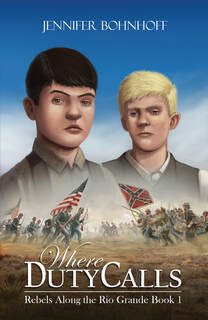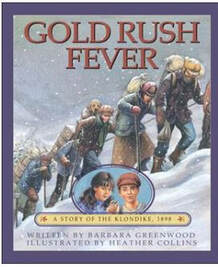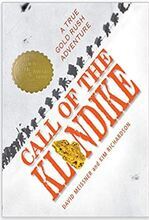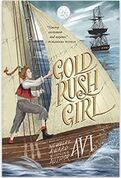There’s Gold in Them Thar Books!
Gold Rush Fever was an important part of America during the nineteenth century. The excitement and intrigue, the adventurous, desperate characters, and the challenges from other miners and from the elements of nature makes for awfully good reading for people of all ages. There is particularly good diggings for middle grade readers, ages 8-14.
The first American gold rush is one that few people remember. In 1799, a twelve-year-old boy named Conrad Reed found a 17-pound nugget of gold near his home in Cabarrus County, North Carolina. Not knowing what it was, the nugget was used as a doorstop until a jeweler recognized it and bought it. In 1802, word got out about the sale of that nugget and the Carolina gold rush was on.
A second gold rush began in Dahlonega, Georgia in 1829. The subsequent influx of miners and immigrants raised tensions with local Cherokee tribes, eventually leading to the forced removal of the tribes in what became known as the "Trail of Tears."
The most famous gold rush in American history began on January 24, 1848, when gold was discovered at Sutter’s Mill in California. The surge ‘forty-niners,” people who immigrated to California hoping to strike it rich, caused California, which was not even a territory of the United States, to get on the fast-track to statehood. As in Georgia, Native Americans living near the goldfields were forcibly removed after clashing with miners. The next gold rush occurred in the Pike's Peak Country of western Kansas Territory and southwestern Nebraska Territory, in what soon became Colorado. The Pike's Peak Gold Rush began in July 1858. The estimated 100,000 gold seekers who took part in this rush were known as "fifty-niners" after 1859, the peak year of the rush. Their motto was “Pike's Peak or Bust!” even though the actual center of the mining activity was 85 miles north.
The next gold rush occurred in the Pike's Peak Country of western Kansas Territory and southwestern Nebraska Territory, in what soon became Colorado. The Pike's Peak Gold Rush began in July 1858. The estimated 100,000 gold seekers who took part in this rush were known as "fifty-niners" after 1859, the peak year of the rush. Their motto was “Pike's Peak or Bust!” even though the actual center of the mining activity was 85 miles north.
Cian Lachlann, one of the main characters in The Worst Enemy, book 2 in my Rebels Along the Rio Grande Trilogy (scheduled for release in 2023) is an orphaned Irish immigrant who becomes one the fifty-niners before joining the Colorado Volunteers and heading into New Mexico. The Book 1, Where Duty Calls, was published last month. It follows two boys through the Confederate invasion of New Mexico, up through the first battle. I am giving away five copies to people who would like a free copy in exchange for an honest critique. Email me at jennifer@jenniferbohnhoff.com if you’d like a copy.
The last great gold rush of the nineteenth century was the Klondike Gold Rush. This rush began in in 1896 when local miners in Yukon, in north-western Canada found gold. When news reached Seattle and San Francisco the following year, thousands of prospectors, known as "Klondikers," flooded the ports of Dyea and Skagway in Southeast Alaska, trekked over the Chilkoot or White Pass trails, then floated down the Yukon River to reach the goldfields. By the time many had made this arduous journey, the land had all been claimed. As with other gold rushes, the indigenous people of the area suffered greatly as their lands were overrun with desperate and unscrupulous prospectors.
If you want to strike gold with a middle grade reader, I suggest you try one of these books: Jasper and the Riddle of Riley's Mine
by Caroline Starr Rose
Jasper and the Riddle of Riley's Mine
by Caroline Starr Rose
Eleven-year-old Jasper Johnson follows his older brother Melvin, who’s run away from their abusive, alcoholic father. The brothers leave the small town of Kirkland, Washington and take a steamer to Alaska to join the Klondike Gold Rush. While he is a stowaway onboard the ship, Jasper overhears men talking about One-Eyed Riley, a prospector who left clues in the form of riddles that will reveal the location of his still-rich stake. Jasper decides he must find Riley’s mine, but in addition to unraveling the clues, the brothers must cross harsh terrain despite increasingly bad weather and having few supplies. Add to this a host of unscrupulous and dangerous people who are also searching for the mine, and the odds against these two boys are almost insurmountable. Jasper’s pluck overcomes many obstacles, and, with the help of a few good people interspersed amid the bad, the brothers find something even more valuable than gold. Caroline Starr Rose does a great job of intermingling facts with a great story so that readers will learn a lot about the history and topography of the Klondike while never feeling lectured to. More books on the Klondike Gold Rush:
More books on the Klondike Gold Rush:
Gold Rush Fever: A Story of the Klondike, 1898 by Barbara Greenwood. 13-year-old Tim and his older brother, Roy, head off to the Klondike Gold Rush, where they face blinding snowstorms, raging rapids, backbreaking work and bitter disappointment. Each chapter in this book ends with facts, information, illustrations and photographs of the people and places of the time, and activities help bring the historical period to life. Call of the Klondike: A True Gold Rush Adventure by David Meissner and Kim Richardson Another story of two young men during the Klondike Gold Rush, this book uses first-hand diaries, letters, telegrams and news articles (written by Pearce) to tell the true story of Marshall Bond and Stanley Pearce, two college buddies who leave Seattle to search for gold. They meet Jack London, the author of Call of the Wild and White Fang, and had an adventure that reads as big as fiction, but is true.
Call of the Klondike: A True Gold Rush Adventure by David Meissner and Kim Richardson Another story of two young men during the Klondike Gold Rush, this book uses first-hand diaries, letters, telegrams and news articles (written by Pearce) to tell the true story of Marshall Bond and Stanley Pearce, two college buddies who leave Seattle to search for gold. They meet Jack London, the author of Call of the Wild and White Fang, and had an adventure that reads as big as fiction, but is true.
 I Escaped The Gold Rush Fever: A California Gold Rush Survival Story
by Scott Peters. It’s 1852, and 14-year-old Hudson runs away from her domineering aunt in San Francisco to go in search of her father. She finds him along the Klamath River, where tempers among the California’s Gold Rush miners and the indigenous people are running high. When anger erupts into murder in an incident based on what is known as the Klamath River Conflict, Hudson finds herself trying to save herself and her wounded father. This fast-paced book 11th in the I Escaped Series, is filled with action and sure to be a hit with fans of the I Survived Series, reluctant readers, and readers with short attention spans. A back section has facts about the California Gold Rush.
I Escaped The Gold Rush Fever: A California Gold Rush Survival Story
by Scott Peters. It’s 1852, and 14-year-old Hudson runs away from her domineering aunt in San Francisco to go in search of her father. She finds him along the Klamath River, where tempers among the California’s Gold Rush miners and the indigenous people are running high. When anger erupts into murder in an incident based on what is known as the Klamath River Conflict, Hudson finds herself trying to save herself and her wounded father. This fast-paced book 11th in the I Escaped Series, is filled with action and sure to be a hit with fans of the I Survived Series, reluctant readers, and readers with short attention spans. A back section has facts about the California Gold Rush.
 More books about the California Gold Rush
More books about the California Gold Rush
Gold Rush Girl, by Avi. Victoria Blaisdell stows away on the ship so that she can accompany her father from Rhode Island to California as he searches for gold. When her younger brother is kidnapped, Tory must search for him in Rotten Row, a part of San Francisco Bay crowded with hundreds of abandoned ships. By the Great Horn Spoon! by Sid Fleischman Twelve-year-old Jack goes to California in search of gold to help his aunt keep her home. His trusty butler, Praiseworthy, joins him on the adventure which will have readers laughing out loud!
By the Great Horn Spoon! by Sid Fleischman Twelve-year-old Jack goes to California in search of gold to help his aunt keep her home. His trusty butler, Praiseworthy, joins him on the adventure which will have readers laughing out loud!
Want even more books about American Gold Rushes for middle grade readers? Check out this list.
 Jennifer Bohnhoff is a retired middle school language arts and history teacher. She now stays home and writes, writes, writes, mostly historical fiction for middle grade readers.
Jennifer Bohnhoff is a retired middle school language arts and history teacher. She now stays home and writes, writes, writes, mostly historical fiction for middle grade readers.
Jennifer is also an affiliate at Bookshop.org, an online bookseller that gives 75% of its profits to independent bookstores, authors, and reviewers. As an affiliate, she receives a commission when people buy books by clicking through links on her blog. A matching commission goes to an independent bookseller.
Please do not see her affiliation with Bookshop.org as a discouragement to shop directly at your local independent bookseller or to borrow from your local library. Everyone should support their public library and local booksellers as much as possible. .
The first American gold rush is one that few people remember. In 1799, a twelve-year-old boy named Conrad Reed found a 17-pound nugget of gold near his home in Cabarrus County, North Carolina. Not knowing what it was, the nugget was used as a doorstop until a jeweler recognized it and bought it. In 1802, word got out about the sale of that nugget and the Carolina gold rush was on.
A second gold rush began in Dahlonega, Georgia in 1829. The subsequent influx of miners and immigrants raised tensions with local Cherokee tribes, eventually leading to the forced removal of the tribes in what became known as the "Trail of Tears."
The most famous gold rush in American history began on January 24, 1848, when gold was discovered at Sutter’s Mill in California. The surge ‘forty-niners,” people who immigrated to California hoping to strike it rich, caused California, which was not even a territory of the United States, to get on the fast-track to statehood. As in Georgia, Native Americans living near the goldfields were forcibly removed after clashing with miners.
 The next gold rush occurred in the Pike's Peak Country of western Kansas Territory and southwestern Nebraska Territory, in what soon became Colorado. The Pike's Peak Gold Rush began in July 1858. The estimated 100,000 gold seekers who took part in this rush were known as "fifty-niners" after 1859, the peak year of the rush. Their motto was “Pike's Peak or Bust!” even though the actual center of the mining activity was 85 miles north.
The next gold rush occurred in the Pike's Peak Country of western Kansas Territory and southwestern Nebraska Territory, in what soon became Colorado. The Pike's Peak Gold Rush began in July 1858. The estimated 100,000 gold seekers who took part in this rush were known as "fifty-niners" after 1859, the peak year of the rush. Their motto was “Pike's Peak or Bust!” even though the actual center of the mining activity was 85 miles north.Cian Lachlann, one of the main characters in The Worst Enemy, book 2 in my Rebels Along the Rio Grande Trilogy (scheduled for release in 2023) is an orphaned Irish immigrant who becomes one the fifty-niners before joining the Colorado Volunteers and heading into New Mexico. The Book 1, Where Duty Calls, was published last month. It follows two boys through the Confederate invasion of New Mexico, up through the first battle. I am giving away five copies to people who would like a free copy in exchange for an honest critique. Email me at jennifer@jenniferbohnhoff.com if you’d like a copy.
The last great gold rush of the nineteenth century was the Klondike Gold Rush. This rush began in in 1896 when local miners in Yukon, in north-western Canada found gold. When news reached Seattle and San Francisco the following year, thousands of prospectors, known as "Klondikers," flooded the ports of Dyea and Skagway in Southeast Alaska, trekked over the Chilkoot or White Pass trails, then floated down the Yukon River to reach the goldfields. By the time many had made this arduous journey, the land had all been claimed. As with other gold rushes, the indigenous people of the area suffered greatly as their lands were overrun with desperate and unscrupulous prospectors.
If you want to strike gold with a middle grade reader, I suggest you try one of these books:
 Jasper and the Riddle of Riley's Mine
by Caroline Starr Rose
Jasper and the Riddle of Riley's Mine
by Caroline Starr RoseEleven-year-old Jasper Johnson follows his older brother Melvin, who’s run away from their abusive, alcoholic father. The brothers leave the small town of Kirkland, Washington and take a steamer to Alaska to join the Klondike Gold Rush. While he is a stowaway onboard the ship, Jasper overhears men talking about One-Eyed Riley, a prospector who left clues in the form of riddles that will reveal the location of his still-rich stake. Jasper decides he must find Riley’s mine, but in addition to unraveling the clues, the brothers must cross harsh terrain despite increasingly bad weather and having few supplies. Add to this a host of unscrupulous and dangerous people who are also searching for the mine, and the odds against these two boys are almost insurmountable. Jasper’s pluck overcomes many obstacles, and, with the help of a few good people interspersed amid the bad, the brothers find something even more valuable than gold. Caroline Starr Rose does a great job of intermingling facts with a great story so that readers will learn a lot about the history and topography of the Klondike while never feeling lectured to.
 More books on the Klondike Gold Rush:
More books on the Klondike Gold Rush:
Gold Rush Fever: A Story of the Klondike, 1898 by Barbara Greenwood. 13-year-old Tim and his older brother, Roy, head off to the Klondike Gold Rush, where they face blinding snowstorms, raging rapids, backbreaking work and bitter disappointment. Each chapter in this book ends with facts, information, illustrations and photographs of the people and places of the time, and activities help bring the historical period to life.
 Call of the Klondike: A True Gold Rush Adventure by David Meissner and Kim Richardson Another story of two young men during the Klondike Gold Rush, this book uses first-hand diaries, letters, telegrams and news articles (written by Pearce) to tell the true story of Marshall Bond and Stanley Pearce, two college buddies who leave Seattle to search for gold. They meet Jack London, the author of Call of the Wild and White Fang, and had an adventure that reads as big as fiction, but is true.
Call of the Klondike: A True Gold Rush Adventure by David Meissner and Kim Richardson Another story of two young men during the Klondike Gold Rush, this book uses first-hand diaries, letters, telegrams and news articles (written by Pearce) to tell the true story of Marshall Bond and Stanley Pearce, two college buddies who leave Seattle to search for gold. They meet Jack London, the author of Call of the Wild and White Fang, and had an adventure that reads as big as fiction, but is true.  I Escaped The Gold Rush Fever: A California Gold Rush Survival Story
by Scott Peters. It’s 1852, and 14-year-old Hudson runs away from her domineering aunt in San Francisco to go in search of her father. She finds him along the Klamath River, where tempers among the California’s Gold Rush miners and the indigenous people are running high. When anger erupts into murder in an incident based on what is known as the Klamath River Conflict, Hudson finds herself trying to save herself and her wounded father. This fast-paced book 11th in the I Escaped Series, is filled with action and sure to be a hit with fans of the I Survived Series, reluctant readers, and readers with short attention spans. A back section has facts about the California Gold Rush.
I Escaped The Gold Rush Fever: A California Gold Rush Survival Story
by Scott Peters. It’s 1852, and 14-year-old Hudson runs away from her domineering aunt in San Francisco to go in search of her father. She finds him along the Klamath River, where tempers among the California’s Gold Rush miners and the indigenous people are running high. When anger erupts into murder in an incident based on what is known as the Klamath River Conflict, Hudson finds herself trying to save herself and her wounded father. This fast-paced book 11th in the I Escaped Series, is filled with action and sure to be a hit with fans of the I Survived Series, reluctant readers, and readers with short attention spans. A back section has facts about the California Gold Rush.  More books about the California Gold Rush
More books about the California Gold RushGold Rush Girl, by Avi. Victoria Blaisdell stows away on the ship so that she can accompany her father from Rhode Island to California as he searches for gold. When her younger brother is kidnapped, Tory must search for him in Rotten Row, a part of San Francisco Bay crowded with hundreds of abandoned ships.
 By the Great Horn Spoon! by Sid Fleischman Twelve-year-old Jack goes to California in search of gold to help his aunt keep her home. His trusty butler, Praiseworthy, joins him on the adventure which will have readers laughing out loud!
By the Great Horn Spoon! by Sid Fleischman Twelve-year-old Jack goes to California in search of gold to help his aunt keep her home. His trusty butler, Praiseworthy, joins him on the adventure which will have readers laughing out loud!Want even more books about American Gold Rushes for middle grade readers? Check out this list.
 Jennifer Bohnhoff is a retired middle school language arts and history teacher. She now stays home and writes, writes, writes, mostly historical fiction for middle grade readers.
Jennifer Bohnhoff is a retired middle school language arts and history teacher. She now stays home and writes, writes, writes, mostly historical fiction for middle grade readers. Jennifer is also an affiliate at Bookshop.org, an online bookseller that gives 75% of its profits to independent bookstores, authors, and reviewers. As an affiliate, she receives a commission when people buy books by clicking through links on her blog. A matching commission goes to an independent bookseller.
Please do not see her affiliation with Bookshop.org as a discouragement to shop directly at your local independent bookseller or to borrow from your local library. Everyone should support their public library and local booksellers as much as possible. .
Published on July 17, 2022 23:00
No comments have been added yet.



